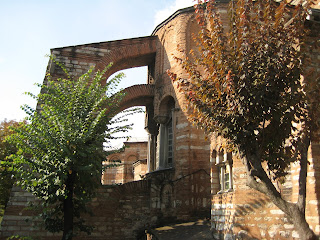Istanbul from the water. The large mosque on the far left is the Blue Mosque, on the right is Hagia Sophia.
Here are some quick facts from wiki:
Istanbul (historically Byzantium and later Constantinople; is the largest city of Turkey and the third largest city in the world. The city covers 27 districts and is located on the Bosphorous Straight and encompasses the natural harbor known as the Golden Horn, in the northwest of the country. It extends both on the European Thrace and on the Asian side of the Bosphorus, and is thereby the only metropolis in the world which is situated on two continents. In its long history, Istanbul served as the capital city of the Roman Empire (330–395), the East Roman (Byzantine Empire)(395–1204 and 1261–1453), the Latin Empire (1204–1261), and the Ottoman Empire (1453–1922).
Me again: as you can see, Istanbul has been under the control of lots of different cultures. This has made the entire city a virtual hodge-podge of culture; we call New York a melting pot, but Istanbul is the real deal. Almost every ancient building in the city has served numerous masters, and the houses of worship have gone through periods of being pagan temples, christian churches, synagogues, and most are now mosques.
Turkey, while a Muslim county, is extremely proud of its status as a secular democracy. It has taken it's cue from the West for decades, and is actively seeking entrance into the EU. The people there value their secular government and consider themselves Western. For what it's worth, I felt completely safe walking around in the city, definitely more so than in Naples. Everyone there was extremely nice, maybe too polite, since those sellers in the Grand Bazaar are looking to take you to the cleaners. :o)
The first stop on our 10 hour tour of the city was the Chora Church/Museum.
From wiki again: The Chora Church ( Kariye Müzesi, Kariye Camii, or Kariye Kilisesi — the Chora Museum, Mosque or Church) is considered to be one of the most beautiful examples of a Byzantine Church. In the 16th century, the church was converted into a mosque by the Ottoman rulers, and it became a secularised museum in 1948. The interior of the building is covered with fine mosaics and frescoes.
The large tower on the left is called a minaret. It has a small balcony at the top and is where the call to worship is given. The number of minarets indicates the size and importance of the mosque.

When you walk into the museum and look to your right, you see this hallway covered in amazing mosaics dating from the early 1300s.
As you look up into the museum's main dome, you see the various scenes of the Virgin and Child.
This is the mosaic of the Koimesis, the Dormition of the Virgin. Before ascending to Heaven, her last sleep. Jesus is holding an infant, symbol of Mary's soul.
As you can see, many of the mosaics have been damaged, probably in earthquakes. But they are still amazingly beautiful.
Coming up tomorrow: the Hippodrome and the Blue Mosque (my favorite thing in Istanbul!).







No comments:
Post a Comment